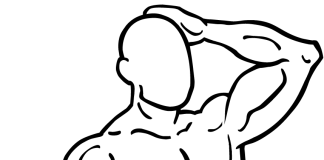Last Updated on September 30, 2022
The alternating bicep curl with dumbbells is a fundamental exercise that targets the biceps, helping to build strength and definition in the upper arms. This exercise is a variation of the traditional bicep curl, focusing on one arm at a time to ensure balanced muscle development and increased concentration on each bicep. In this comprehensive guide, we will delve into the details of performing the alternating bicep curl correctly, discuss its benefits, provide tips for maximizing your workout, and explore variations to keep your routine exciting and effective.
Understanding the Alternating Bicep Curl
The alternating bicep curl is a single-arm version of the classic bicep curl. By focusing on one arm at a time, this exercise allows for greater concentration and control, which can lead to improved muscle engagement and growth. It is a versatile exercise that can be incorporated into various workout routines, whether you’re a beginner or an experienced lifter.
Step-by-Step Guide to Performing the Alternating Bicep Curl
To perform the alternating bicep curl with dumbbells effectively, follow these detailed steps:
- Starting Position:
- Stand with your feet shoulder-width apart to ensure stability and balance.
- Keep your knees slightly bent to reduce strain on your lower back.
- Engage your core by drawing in your abs, which helps maintain proper posture throughout the exercise.
- Grasping the Dumbbells:
- Hold a dumbbell in each hand with your palms facing upward. This grip is known as the supinated grip, which targets the biceps more effectively.
- Extend your arms so they are positioned at the sides of your body, ensuring that your elbows are close to your torso.
- Executing the Curl:
- Keeping your elbows locked in position, lift your left arm towards your chest. Focus on contracting your bicep as you lift the dumbbell.
- Continue lifting until your forearm touches your bicep, ensuring a full range of motion for maximum muscle engagement.
- Slowly lower your left arm back to the starting position, maintaining control to avoid swinging.
- Alternating Arms:
- Repeat the curling motion with your right arm, following the same steps to lift and lower the dumbbell.
- Continue alternating between your left and right arms for the desired number of repetitions.
Key Tips for an Effective Workout
- Avoid Body Swinging: One of the most common mistakes during bicep curls is using momentum to lift the weights. Focus on using your biceps to lift the dumbbells, keeping your body stable and avoiding any swinging motion.
- Control the Movement: Both the lifting and lowering phases of the curl should be performed with control. This ensures that the biceps are engaged throughout the entire movement, leading to better muscle development.
- Choose the Right Weight: Select a dumbbell weight that allows you to perform the exercise with proper form. If the weight is too heavy, you may compromise your technique, reducing the effectiveness of the exercise.
- Breathe Properly: Inhale as you lower the dumbbell and exhale as you lift it. Proper breathing helps maintain focus and provides the necessary oxygen to your muscles.
Benefits of the Alternating Bicep Curl
Incorporating the alternating bicep curl into your workout routine offers several benefits:
- Improved Muscle Symmetry: By working one arm at a time, you can identify and address any muscle imbalances, leading to more symmetrical bicep development.
- Enhanced Focus and Concentration: Focusing on one arm at a time allows for greater mental concentration on the muscle being worked, which can improve muscle activation and growth.
- Versatility: This exercise can be performed with various weights and rep ranges, making it suitable for different fitness levels and goals.
Variations to Challenge Your Muscles
To keep your workouts interesting and continue progressing, consider incorporating these variations of the alternating bicep curl:
- Hammer Curl Variation: Instead of the supinated grip, use a neutral grip with your palms facing each other. This variation targets the brachialis, a muscle located beneath the biceps, adding thickness to your arms.
- Incline Alternating Bicep Curl: Perform the exercise while seated on an incline bench. This variation increases the range of motion and emphasizes the stretch on the biceps.
- Resistance Band Alternating Curl: Use resistance bands instead of dumbbells to add variety and challenge your muscles with constant tension throughout the movement.
Incorporating the Alternating Bicep Curl into Your Workout Routine
The alternating bicep curl can be included in various types of workout routines, whether you’re focusing on strength, hypertrophy, or endurance. Here are some examples of how to incorporate this exercise:
- Strength Training: Perform 3-4 sets of 6-8 repetitions with heavier weights to build bicep strength.
- Hypertrophy Focus: Aim for 3-4 sets of 8-12 repetitions with moderate weights to promote muscle growth.
- Endurance and Toning: Use lighter weights and perform 3-4 sets of 15-20 repetitions to improve muscle endurance and tone.
Common Mistakes and How to Avoid Them
To maximize the benefits of the alternating bicep curl, be aware of these common mistakes and learn how to avoid them:
- Using Excessive Weight: Lifting too heavy can lead to poor form and increase the risk of injury. Choose a weight that allows you to maintain proper technique throughout the exercise.
- Neglecting the Lowering Phase: The eccentric (lowering) phase of the curl is just as important as the concentric (lifting) phase. Lower the dumbbell slowly and with control to maximize muscle engagement.
- Allowing Elbows to Drift Forward: Keep your elbows close to your body to ensure that the biceps are the primary muscles being worked. Allowing the elbows to drift forward can shift the focus away from the biceps.
The alternating bicep curl with dumbbells is a versatile and effective exercise that can help you achieve well-defined and strong biceps. By following the proper technique, incorporating variations, and avoiding common mistakes, you can maximize the benefits of this exercise and enhance your overall arm development. Whether you’re a beginner or an experienced lifter, the alternating bicep curl is a valuable addition to any workout routine, offering both aesthetic and functional benefits. So grab your dumbbells, focus on your form, and start curling your way to stronger, more defined arms!








